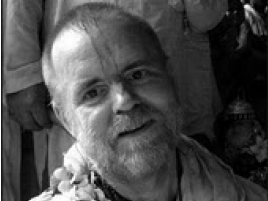In Loving Memory of Aindra Das
By Kaustubha Das | Jul 22, 2010

The first time I visited India was in 1989. My flight arrived at the Delhi Airport at some early hour and I took a precarious taxi ride through the morning fog to the holy town of Vrindavan. Upon arriving, I prostrated in the dust of Vraja and headed straight for the Krishna Balaram Temple. It was shortly after the daily scriptural discourse and the place was nearly empty. As I approached the foot of the alter a musician caught my attention. He was alone, sitting before the shrine of Sri Sri Radha Syamsundar. He appeared austere. It was cold and he was wrapped in a ragged wool shawl. His music was unlike anything I had heard before. The melody was stripped bare. A desolate voice accompanied only by a frail harmonium scale, slow and slightly off beat – crawling, barely dragging along. His song was the cry of a dying man. A man in the desert, drying up and desperate, crying for some water – just a small cup – just a drop. It was almost pitiful, but hauntingly beautiful – like nothing I’d heard before. It sounded so remorseful, so humble and completely sincere. It was the first time I heard a man desperately crying out to God.
The musician was Aindra das. An American who had given up his citizenship to settle in Vrindavan with an unbreakable, one pointed focus – to sing before Radha Syamsundar until the day he died. Aindra had complete conviction. Conviction that Vrindavan was no ordinary village – it was the highest spiritual abode. Conviction that kirtan was no ordinary music – it was the divine name, descended from above, non-different from Radha and Krishna. He had no interest to be anywhere else or do anything else. He was convinced that by sitting in that spot he could change the world through his song.
Aindra das lived in a room on the third floor of a school for boys, adjacent to the temple. His entire life was comprised of the practice of Krishna bhakti. He would read, discuss and contemplate the esoteric bhakti scriptures in that room, late into the night. He would perform the sacred bhakti rituals in that room with the utmost sincerity. At four in the morning, he would enter the temple to observe the mangala-arati, and then he would step into the temples sanctum-sanctorium to perform the service of alankara, dressing the divine forms of Radha Syamsundara. Although Aindra dressed himself practically in rags, his refined fashion sense was expressed through the exceptional artistic beauty of his service to Radhe Shyam. Later he would take a little rest, then back to kirtan. Every evening he would sing in the temple to the delight of thousands.
Of course it was kirtan that Aindra was known for. How to describe it? It would often start gently – so delicate and soft. As the subtleties of the melody became more apparent and everyone became more confident in responding, you could feel the kirtan grow. It might be slow, graceful and ornate, but you could begin to feel the power just beneath the surface. Soon, under his meticulous direction, the drum beat would grow. Aindra always had a team of fantastic drummers. They would travel across the world for the privilege not just to play for him, but to learn from him. Or more precisely, to try to somehow capture just a bit of his realization and love of kirtan. As the beat grew and his voice gained strength it would become clear that although the kirtan was slow, it was massive. It was an elephant struggling to stand, sluggish but powerful. Step by brawny step the elephant would push forward, growing in strength. This kirtan was a thing of beauty. You would feel your heart pulled along through so many emotions. Joy and pain, wonder and regret, all were sublime in his kirtan. They were so satisfying, nourishing, edifying to the experience of bhakti. Nightly, large, international groups of people would join together in song and become one – one group united in devotion. Smiles and tears, so many varieties of dance. It was always a joy to see large groups of Indian villagers enter the temple on pilgrimage and take such delight in his kirtan. He never failed to astonish them, this white-boy with such deep devotion, playing their folk music with more energy and skill then they had ever seen. The joy in the faces of the ladies as they raised their arms, and danced. The village men, smiling with their missing teeth, clapping their hands, throwing back their heads and crying out. And the kirtan would just keep growing. It was epic, heroic, relentless, all consuming. He would sing, then he would roar. The earth would shake, until finally – JAYA JAYA SRI RADHEEEEEEEEEEEEEE SHYAM!
Read more: http://bhakticollective.com/2010/07/17/in-loving-memory-of-aindra-das-2/















